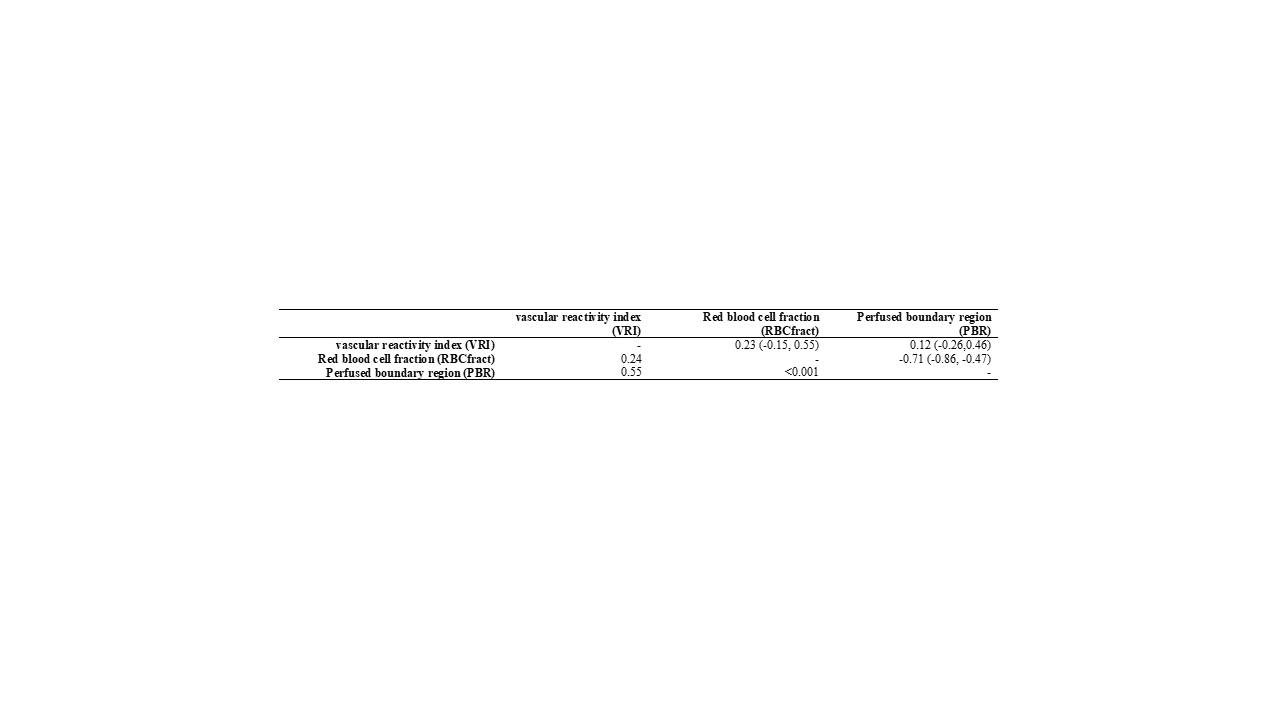Session Information
Session Type: Poster Session B
Session Time: 9:00AM-11:00AM
Background/Purpose: Sublingual microscopy is reported as a useful tool for vasculopathy assessment in SSc. Digital thermal monitoring (DTM) correlates with flow-mediated dilatation, and may identify patients at risk for digital ulcer (DU). The purpose of this analysis was to assess sublingual microscopy and DTM in SSc patients with and without digital ulcers in order to determine the utility of these clinical tools for end-stage vasculopathy assessment.
Methods: Consented SSc registry patients that presented for routine clinical care and had both DTM and sublingual microscopy on the same day were included in this cross-sectional analysis. Measurements were performed in a quiet room at a controlled ambient temperature. DTM records a temperature rebound in the fingertip after blood pressure cuff occlusion, and is provided as a single, automated vascular reactivity index (VRI) value. Sublingual microscopy provides an automated measure of microvascular perfusion (longitudinal red blood cell fraction, RBC fract) and glycocalyx penetrability (perfused barrier region, PBR). We summarized demographics and clinical outcomes of interest using median, interquartile range (IQR) and range for skew continuous variables; we reported counts and percentages for categorical variables. Exact Wilcoxon rank sum test and Fisher’s exact test were used to compare variable between DU groups. We evaluated the pairwise association between VRI, RBCfract and PBR in a monotonic relationship using Spearman’s rank correlation in the DU subset. We reported the correlation coefficients (r-s) and their 95% confidence intervals (CIs). We also reported the asymptotic p-values. Statistical significance was assessed at the 0.05 level.
Results: Of the 90 patients that met inclusion criteria, 29 had digitals pits and/or active DU and 61 never had a DU (Table 1). These patients were 76% female, 83% white, 11% current smoker, and 87% SSc-specific autoantibody positive. At the time of assessment, 91% were on vasodilators for Raynaud’s phenomenon. The only significant clinical feature associated with the presence of DU was modified Rodnan skin score (p=0.003). The VRI captured by DTM was lower in patients with DU (p=0.01). The sublingual microscopy RBCfract and PBR were monotonic associated (p < 0.001) with monotone decreasing with the higher RBCfract the lower PBR (r¬s=-0.71, 95% CI: -0.86, -0.47). VRI was not associated with RBCfract or PBR (p=0.24 or 0.55, respectively) in the small group DU patients (Table 2).
Conclusion: DTM, which captures damage as a vasculopathy feature, is a potentially useful tool for assessing DU risk in the SSc population. In this cross-sectional analysis, sublingual microscopy measurements of perfusion and glycocalyx penetrability did not significantly correlate to VRI in DU patients’ assessment. However, a longitudinal study of these sublingual microscopy parameters may be more helpful in capturing vasculopathy activity prior to the possibly irreversible damage that is captured by DTM.
 Clinical Features of 90 SSc patients assessed with Digital Thermal Monitoring and Sublingual Microscopy
Clinical Features of 90 SSc patients assessed with Digital Thermal Monitoring and Sublingual Microscopy
 Spearman’s rank correlation and 95% CI for 29 DU patients.
Spearman’s rank correlation and 95% CI for 29 DU patients.
To cite this abstract in AMA style:
Frech T, Ou Z, Thomas J, Presson A. Clinical Bedside Tools to Assess Systemic Sclerosis Vasculopathy: Can Digital Thermal Monitoring and Sublingual Microscopy Identify Patients with Current or past Digital Ulcers? [abstract]. Arthritis Rheumatol. 2020; 72 (suppl 10). https://acrabstracts.org/abstract/clinical-bedside-tools-to-assess-systemic-sclerosis-vasculopathy-can-digital-thermal-monitoring-and-sublingual-microscopy-identify-patients-with-current-or-past-digital-ulcers/. Accessed .« Back to ACR Convergence 2020
ACR Meeting Abstracts - https://acrabstracts.org/abstract/clinical-bedside-tools-to-assess-systemic-sclerosis-vasculopathy-can-digital-thermal-monitoring-and-sublingual-microscopy-identify-patients-with-current-or-past-digital-ulcers/
